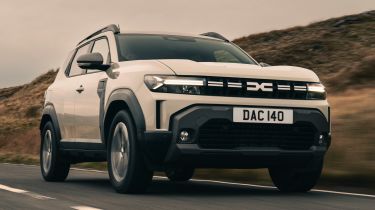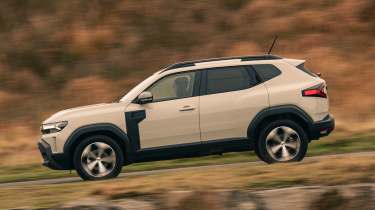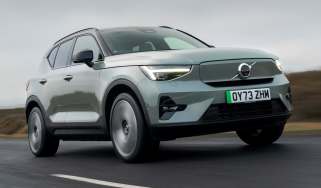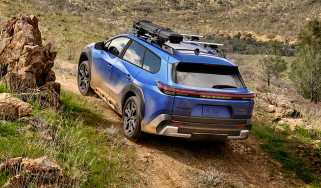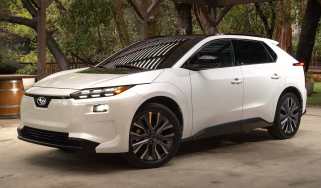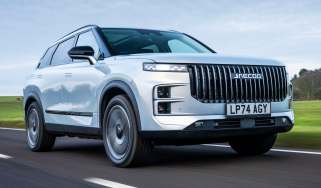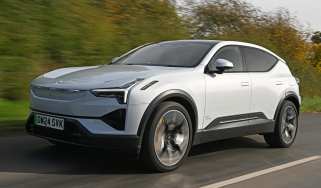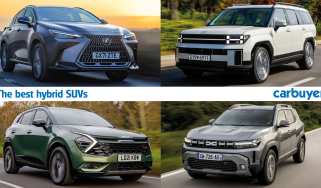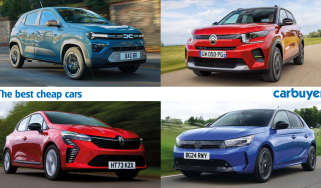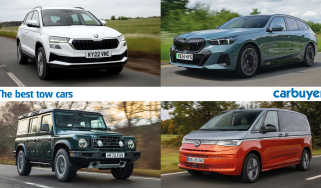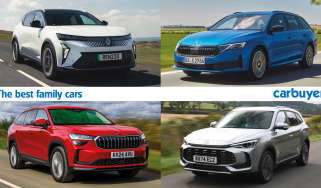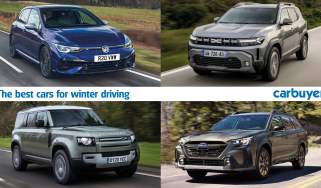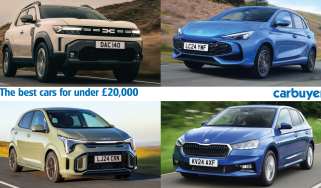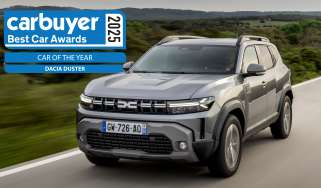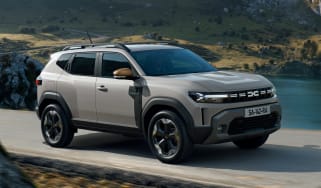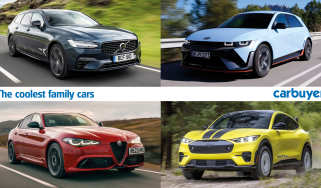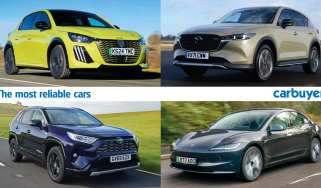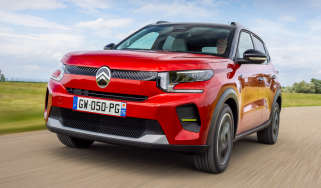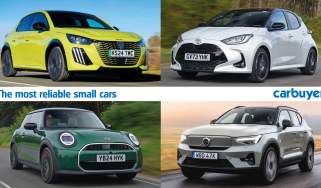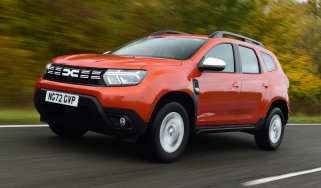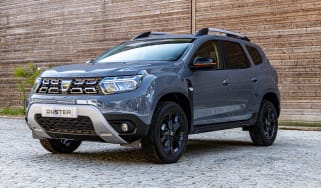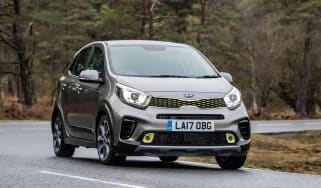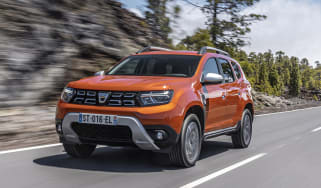Dacia Duster review – a budget family SUV favourite
“The latest Dacia Duster has more character than ever, offering the same great value as before, with added practicality and style”
Pros
- Efficient hybrid technology
- Genuine off-roading capability
- Lots of practical features
Cons
- Low-quality interior plastics
- Not as refined as some rivals
- Safety score is a grey area
Verdict – is the Dacia Duster a good car?
The latest Dacia Duster has stayed true to its ethos of offering a lot of car for a low price. Great value is the name of the game, and it’s even more practical and well-engineered than before, with clever features that give rivals like Skoda a run for their money. Mild-hybrid and full-hybrid engines mean it’s more economical to run than before, and you can even get a genuinely off-road-capable four-wheel drive version. It’s not perfect, however, with some low-quality materials on the inside, and you will find more refined rival SUVs out there, but the Duster really delivers and should be on every family-car buyer’s shortlist. In fact, it’s so good, we named it our Carbuyer Car of the Year for 2025.
Dacia Duster models, specs and alternatives
Dacia has quickly made a name for itself since it arrived in the UK, and one of its most popular models, the Dacia Duster SUV, is now in its third generation. The first model was pretty basic, using old Renault technology to keep costs down, while the second generation model brought a more modern look and was based on updated underpinnings. The Duster is Dacia’s most popular model worldwide, racking up in excess of 2.4 million sales, so it’s a very important car for the Romanian brand.
More reviews
We think this third-generation model is brilliant to look at. The first impressions we get are of almost concept-car styling which gives the Duster an ultra-modern exterior design that makes it seem more upmarket than before, as well as appearing more like an off-roader than an SUV. You’d be forgiven for expecting it to have also ballooned in price, but starting from under £19,000 to buy and less than £200 a month on a PCP finance deal, the brand has remained true to its affordable ethos. It significantly undercuts models like the top-selling Ford Puma that costs from around £26,000, while the Renault Captur kicks off from closer to £21,000.
This is somewhat evident on the inside of the Dacia Duster – don’t expect high levels of quality in such a budget-friendly SUV, as material quality isn’t the best. With that said, build quality as a whole is better than in the outgoing car.
There’s a choice of four trims, with the Duster Essential, Expression and Journey touted as more urban-focused, while the Extreme model is slightly more rugged and geared towards exploring the outdoors.
For the first time, the Duster is offered with a hybrid powertrain like its sibling the Dacia Jogger. This makes use of the same 1.6-litre petrol engine and electric motor as used in the Jogger, but there will also be a cheaper 1.2-litre mild-hybrid variant, and we’ve now had the chance to test both versions, along with a 1.0-litre petrol Bi-Fuel that can also run on LPG. The Duster has a reputation for being rugged, and Dacia is pitching some models of the Duster as genuinely off-road-capable, but it’s worth noting it’s offered in two-wheel drive and four-wheel drive guise, which will have a big effect on how far off the beaten track you can go.
| Trim levels | Power options |
|
|
MPG, running costs & CO2 emissions
The latest Dacia Duster is more economical than before, with even the 1.2-litre petrol engine getting mild-hybrid assistance to improve efficiency and return up to 51.4mpg. For the first time there’s also a full-hybrid version of the Dacia Duster, badged Hybrid 140, which takes the same system used in the Jogger for the utmost in fuel efficiency, and it’s capable of up to 56.3mpg. There are no diesel versions of the Duster this time around. Read more about the Dacia Duster's MPG, running costs and CO2 emissions...
Engines, drive & performance
While you shouldn’t expect a particularly engaging driving experience from a car like the Dacia Duster, it’s fairly easy to drive and the 1.2-litre mild-hybrid feels like it has enough power and capability. Even with a manual gearbox, it feels smooth to drive, but the Hybrid 140’s automatic gearbox makes it even more effortless from behind the wheel. The four-wheel drive version feels genuinely capable off the beaten track, and it’s worth your consideration if you plan on using the Duster for off-roading. Read more about the Dacia Duster's engines, drive and performance...
Interior & comfort
The Dacia Duster’s interior is where you’ll most notice its budget-friendly approach, as many of the interior plastics are of lower quality. That said, it’s well put together, and while the infotainment system doesn’t reinvent the wheel, it feels easy to use and is responsive enough. Equipment levels are a bit spartan on entry-level models, but most buyers could go for a mid-range car and not be left wanting for more. Read more about the Dacia Duster's interior and comfort...
Practicality & boot space
The Duster is a practical and highly usable car for its size, and we love the latest version’s handy YouClip system. This allows you to mount different clips around the cabin for extra storage, hanging coats or devices and more. Full-grown adults will be comfortable sitting up front or in the back, and boot space has grown over that of the old model, so the car’s slight increase in size has been used well. Read more about the Dacia Duster's practicality and boot space
Reliability & safety
Safety will be an area of concern for many buyers, given the Dacia Duster’s middling three-star Euro NCAP rating, and Dacia’s reliability record has been worse than average. With the latest Dacia Duster too new to assess on the latter front and yet to be tested by Euro NCAP, it’s yet to be seen whether the increased amount of safety kit makes for a better score this time around. Driver Power customer satisfaction survey results put Dacia as a brand far behind many other manufacturers, but the previous-generation Duster was rated highly, coming in fourth place out of the top 75 cars, so the latest model can hopefully build on this. Read more about the Dacia Duster's reliability and safety
Dacia Duster alternatives
The Dacia Duster is easily the cheapest SUV for its size, but it has a long list of small and mid-size SUV rivals buyers might consider alongside it.
Should you buy a Dacia Duster?
The Dacia Duster has proven popular with buyers thanks to its undeniably good value for money and practicality. The outgoing model even came first in our Driver Power customer satisfaction survey for 2024, so the new model has a lot to live up to. It’s certainly off to a flying start; we’ve made it our Carbuyer Car of the Year for 2025.
Dacia has made a name for itself, and we like the fact that the new Duster’s rugged styling leans into the SUV character, hiding its hatchback Clio and Sandero underpinnings so well you’d never know they were related. Our drive of the Duster also proved it can back up its 4x4 looks with some genuine off-roading capability, and yet it felt just as at home in urban environments.
If cabin quality is a priority then you’d be better off looking elsewhere, because there’s evidence of cost-cutting when it comes to the materials used on the Dacia Duster’s interior. In all honesty, though, we think that’s a small price to pay for how well-rounded the Duster feels in other areas.
While Dacia has made leaps with a longer list of safety equipment for the Duster this time around, there’s no denying that the previous car’s one-star Euro NCAP result could be off-putting for many buyers, so we’ll be interested to see whether the brand had improved the new car significantly enough in this area.
What is the best Dacia Duster for low running costs?
The Dacia Duster now comes with the choice of a Hybrid 140 model which uses the same system first employed in the Jogger MPV. This is the most economical of the bunch, but also more expensive, so it’s worth weighing up whether you’re likely to do enough miles in it day-to-day to make a difference to your wallet. The 1.2-litre’s mild-hybrid system makes it more frugal than that of the outgoing model, and no version of the Duster is likely to cost the earth to run.
What is the Carbuyer pick of the Dacia Duster range?
If we were configuring a Duster we’d stick with the 1.2-litre mild-hybrid engine, then use the money we’d saved to step up to mid-range Expression trim. Essential is a bit too spartan for our liking, and the Expression’s 10.1-inch infotainment with wireless Android Auto and Apple CarPlay makes the sat nav offered on higher trims feel mostly redundant.
How we tested the Dacia Duster
We tested left-hand drive versions of the two-wheel drive and four-wheel drive 1.2-litre Dacia Duster, as well as the Hybrid 140 model in Malaga, Spain in April 2024 in dry sunny conditions. Since then, we’ve also tested a right-hand drive Duster Hybrid on British roads in October 2024.
